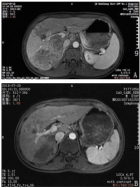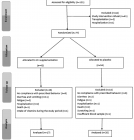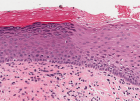Abstract
Case Report
Clinical presentation, diagnosis and therapeutic management of Dipylidium caninum (Cestoda: Dilepididae) infection in a domestic cat (Felis catus): a case report
Md. Shahadat Hossain, Ausraful Islam, Sharmin Shahid Labony, Md. Mokbul Hossain, Md. Abdul Alim and Anisuzzaman*
Published: 15 November, 2021 | Volume 5 - Issue 1 | Pages: 024-025
Background: Dipylidium caninum, a zoonotic cyclophyllidean tapeworm, mainly infects dogs, cats, and occasionally humans as well. Here, we present D. caninum infection in a domestic cat. A cat of about one year of age with a history of intermittent diarrhea and shedding stool containing whitish cooked rice like soft particles.
Methods: The case was identified by thorough clinical, coprological, and parasitological examinations, and treated accordingly.
Results: During the physical examination, the cat was found to be infested with flea, and coprological investigation revealed the presence of gravid segments of cestodes. By preparing a permanent slide, we conducted a microscopic examination, and the cestode was confirmed as D. caninum. The cat was treated with albendazole and levamisole, which were ineffective; additionally, levamisole showed toxicity. Then, we administered niclosamide which completely cured the animal. On re-examination after a week, feces were found negative for eggs/gravid segments of any cestode.
Conclusion: Niclosamide was found effective against dipylidiasis and can be treated similar infections in pets.
Read Full Article HTML DOI: 10.29328/journal.ivs.1001032 Cite this Article Read Full Article PDF
Keywords:
Dipylidium caninum; Domestic cat; Niclosamide; Albendazole; Levamisole
References
- Taylor MA., Coop RL, Wall RL. Veterinary parasitology.Wiley-Blackwell. Oxford. 2007; 373–375.
- Yasuda F, Hashiguchi J, Nishikawa H, Watanabe S. Studies on the life history of Dipylidium caninum. Nippon Vet Zootech Coll Bull. 1968; 17: 27-32.
- Soulsby EJL. Helminths, arthropods and protozoa of domesticated animals. Bailliere Tindall. London. 1982; 763–766.
- Ramana KV, Rao SD, Rao R, Mohanty SK, Wilson CG. Human dipylidiasis: a case report of Dipylidium caninuminfection from Karimnagar. Online J Health Allied Sci. 2011; 10: 28.
- Narasimham MV, Panda P, Mohanty I, Sahu S, Padhi S, et al. Dipylidium caninuminfection in a child: a rare case report. Indian J Med Microbiol. 2013; 31: 82–84. PubMed:https://pubmed.ncbi.nlm.nih.gov/23508438/
- Ash LR. Helminth parasites of dogs and cats in Hawaii. J Parasitol. 1961; 48: 63-65. PubMed: https://pubmed.ncbi.nlm.nih.gov/13862798/
- Wilson-Hanson SL, Prescott CW. A survey for parasites in cats. Aust Vet J. 1982; 59: 194. PubMed: https://pubmed.ncbi.nlm.nih.gov/7168726/
- Baker MK, Lange L, Verster A, Van der Plaat S. A survey of helminths in domestic cats in the Pretoria area of Transvaal, Republic of South Africa. Part 1: The prevalence and comparison of burdens of helminths in adult and juvenile cats. J S Afr Vet Ass. 1989; 60: 139-142. PubMed: https://pubmed.ncbi.nlm.nih.gov/2634770/
Figures:

Figure 1
Similar Articles
-
Clinical presentation, diagnosis and therapeutic management of Dipylidium caninum (Cestoda: Dilepididae) infection in a domestic cat (Felis catus): a case reportMd. Shahadat Hossain,Ausraful Islam,Sharmin Shahid Labony,Md. Mokbul Hossain,Md. Abdul Alim,Anisuzzaman*. Clinical presentation, diagnosis and therapeutic management of Dipylidium caninum (Cestoda: Dilepididae) infection in a domestic cat (Felis catus): a case report. . 2021 doi: 10.29328/journal.ivs.1001032; 5: 024-025
Recently Viewed
-
Myxedema Coma and Acute Respiratory Failure in a Young Child: A Case ReportRinah Elaisse R Dolores, Marion O Sanchez*. Myxedema Coma and Acute Respiratory Failure in a Young Child: A Case Report. Ann Clin Endocrinol Metabol. 2023: doi: 10.29328/journal.acem.1001027; 7: 008-013
-
Navigating Weight Management with Stevia: Insights into Glycemic ControlShashikanth Kharat*, Sanjana Mali*. Navigating Weight Management with Stevia: Insights into Glycemic Control. New Insights Obes Gene Beyond. 2024: doi: 10.29328/journal.niogb.1001021; 8: 006-008
-
Screening for Depressive Symptoms in Clinical and Nonclinical Youth: The Psychometric Properties of the Dutch Children’s Depression Inventory-2 (CDI-2)Denise Bodden*. Screening for Depressive Symptoms in Clinical and Nonclinical Youth: The Psychometric Properties of the Dutch Children’s Depression Inventory-2 (CDI-2). Insights Depress Anxiety. 2025: doi: 10.29328/journal.ida.1001047; 9: 028-039
-
The Bacteriological Profile of Nosocomial Infections at the Army Central Hospital of BrazzavilleMedard Amona*,Yolande Voumbo Matoumona Mavoungou,Hama Nemet Ondzotto,Benjamin Kokolo,Armel Itoua,Gilius Axel Aloumba,Pascal Ibata. The Bacteriological Profile of Nosocomial Infections at the Army Central Hospital of Brazzaville. Int J Clin Microbiol Biochem Technol. 2025: doi: 10.29328/journal.ijcmbt.1001032; 8: 009-022
-
Indian spices and Caffeine treatment for Obesity and Cardiovascular diseaseIan James Martins*. Indian spices and Caffeine treatment for Obesity and Cardiovascular disease. Ann Clin Endocrinol Metabol. 2018: doi: 10.29328/journal.acem.1001005; 2: 010-014
Most Viewed
-
Impact of Latex Sensitization on Asthma and Rhinitis Progression: A Study at Abidjan-Cocody University Hospital - Côte d’Ivoire (Progression of Asthma and Rhinitis related to Latex Sensitization)Dasse Sery Romuald*, KL Siransy, N Koffi, RO Yeboah, EK Nguessan, HA Adou, VP Goran-Kouacou, AU Assi, JY Seri, S Moussa, D Oura, CL Memel, H Koya, E Atoukoula. Impact of Latex Sensitization on Asthma and Rhinitis Progression: A Study at Abidjan-Cocody University Hospital - Côte d’Ivoire (Progression of Asthma and Rhinitis related to Latex Sensitization). Arch Asthma Allergy Immunol. 2024 doi: 10.29328/journal.aaai.1001035; 8: 007-012
-
Causal Link between Human Blood Metabolites and Asthma: An Investigation Using Mendelian RandomizationYong-Qing Zhu, Xiao-Yan Meng, Jing-Hua Yang*. Causal Link between Human Blood Metabolites and Asthma: An Investigation Using Mendelian Randomization. Arch Asthma Allergy Immunol. 2023 doi: 10.29328/journal.aaai.1001032; 7: 012-022
-
An algorithm to safely manage oral food challenge in an office-based setting for children with multiple food allergiesNathalie Cottel,Aïcha Dieme,Véronique Orcel,Yannick Chantran,Mélisande Bourgoin-Heck,Jocelyne Just. An algorithm to safely manage oral food challenge in an office-based setting for children with multiple food allergies. Arch Asthma Allergy Immunol. 2021 doi: 10.29328/journal.aaai.1001027; 5: 030-037
-
Snow white: an allergic girl?Oreste Vittore Brenna*. Snow white: an allergic girl?. Arch Asthma Allergy Immunol. 2022 doi: 10.29328/journal.aaai.1001029; 6: 001-002
-
Cytokine intoxication as a model of cell apoptosis and predict of schizophrenia - like affective disordersElena Viktorovna Drozdova*. Cytokine intoxication as a model of cell apoptosis and predict of schizophrenia - like affective disorders. Arch Asthma Allergy Immunol. 2021 doi: 10.29328/journal.aaai.1001028; 5: 038-040

If you are already a member of our network and need to keep track of any developments regarding a question you have already submitted, click "take me to my Query."

















































































































































